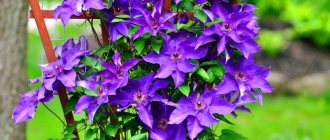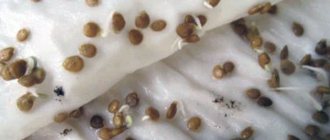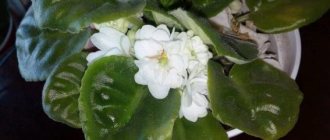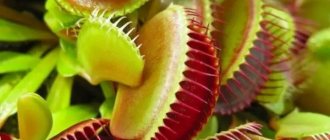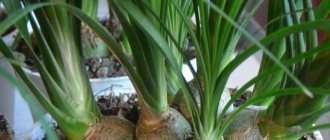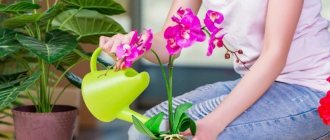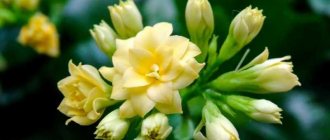Updated: 05/28/2021 10:38:34
Expert: Knyazeva Albina Andreevna
Comfort in the house is created by accents. One of them is the presence of indoor flowers. The condition of the plants on the windowsills serves as an indicator of the family microclimate. An old sign - indoor flowers prosper - the family is strong and friendly. To create a mini-garden in an apartment you need patience, observation and hard work. It’s not easy to pick up the key to each bush, find a place for it, and not offend it when caring for it.
Humidity
Air humidity is important for the normal development of indoor plants. Cacti, olive, oleander and some other plants from dry regions of the globe prefer dry air. They grow, bloom and bear fruit better. In hot weather, to humidify the air, pots with plants are placed on low trays covered with a layer of fine gravel and filled with water. Water, evaporating, creates a humid atmosphere around the plants. In summer, it is better to spray the plants 2-3 times a day with water at room temperature. For many plants, this procedure is very useful in winter, especially in an apartment with central heating. When spraying, try not to get water on the blooming flowers. You can increase air humidity by placing pots of plants in boxes filled with moist peat. A pleasant life for a moisture-loving plant is ensured by placing its pot in a larger one. The space between the pots is filled with wet peat. Philodendron, monstera and some other plants have aerial roots. They need to be sprayed regularly to avoid drying out.
Replanting an indoor flower
- Remove the plant from the store-bought container to avoid damaging the roots. An hour before transplanting, water thoroughly. Do not pull on the stem; turn the pot over, supporting the surface of the soil and the root zone with your hand. Wiggle the bottom of the container so that the bush gently lowers to the table surface. Lightly shake off the earthen ball.
- If the root system has grown too much, trim the ends with pruning shears. Sprinkle the sections with crushed activated carbon tablets to prevent infection.
- Prepare the pot, add drainage. Fill the container halfway with soil.
- Place the flower in the middle. Carefully fill the sides with soil up to the edge of the pot. Lightly compact the soil with your fingers. The entire stem should be above the soil surface.
- Water when the air pockets disappear and the soil settles. If necessary, add soil mixture. The root head should be underground.
- Place the pot in the chosen place and do not disturb it for several days. Replanting is always a shock for an indoor flower.
- What is content on Tele2: how to connect subscriptions
- Eco slim for weight loss - composition and effect of the drug
- How to treat erysipelas - methods of therapy with ointments, antibiotics and folk remedies at home
Watering
One of the main tasks of a gardener is to learn to recognize the water needs of each indoor plant. After all, excess water or lack of it leads to the death of the plant. There are two ways to water indoor plants. First: water the soil in the pot until water appears in the pan. The second is to pour water directly into the pan. Both methods have disadvantages. When watering from above, the soil is not always saturated with water, and the lower layers of the root system remain dry. When watering from below, the water does not always reach the top of the ground. Therefore, it is best to combine both methods. Epiphyte plants and dried out plants should be immersed in water along with the pot for 35-50 seconds. After watering, the water accumulated in the trays must be removed. In the summer, to avoid large losses of moisture, cover the soil in pots with moss, peat or dry plant residues with a layer of 2-3 cm. Water with water at room temperature as the soil dries, preferably in the evening. After watering, it is important to loosen the soil.
It is best to water indoor plants with rainwater, since tap water contains bleach. In order for the chlorine to evaporate from the water and the lime to settle, the water must be left to stand for 12-14 hours. Or add soda to it (0.5 teaspoon per 1 liter). In summer, it is recommended to water some moisture-loving plants twice a day - in the morning and in the evening. In summer, plants are watered in the evening, and in late autumn and winter - in the morning. Transplanted plants should be watered less frequently, since the roots have not yet penetrated the soil and water is absorbed slowly. To avoid burns, do not water plants exposed to direct sunlight. And remember: watering should be increased during the flowering time of plants.
An important feature of the light in the room is that it is directed one way. It is towards the windows that plants turn their leaves, grow shoots, and bend. Rotating the plants regularly helps somewhat. Plants are usually turned twice a season - in autumn and spring. There are plants that do not like to turn around, such as cacti. For them, a change in the position of the sun is a signal of danger (in nature this happens if a plant is torn out, the root system is damaged, etc.). When turning around or changing the lighting, cacti that are about to bloom can drop their buds or turn them into ordinary shoots. Plants with green leaves do much better in low light than their variegated relatives. During the flowering period, plants should receive a certain dose of direct sunlight every day. The level of illumination for each plant is individual.
Direct sunlight is necessary for long-flowering plants, some cacti, agaves, aloe, bulbous, oleander, pelargonium, gerbera, etc. In a room, it is better to place such a plant on a well-lit windowsill, but without touching the glass. Most indoor plants need light coming in through windows and some sun. These are achimenes, caladium, arrowroot, bougainvillea, peperomia, etc. Remember, the morning sun is not as strong and hot as the afternoon sun. Therefore, try to provide your plants with at least two hours of sunlight every day, but not daylight. Fuchsia, philodendron, ferns can easily tolerate partial shade... This is not difficult to do by placing the plants on shaded windows.
Keep ivy, river begonia, monstera, some bromeliads, and certain types of ferns as far as possible from light sources. In winter, there is no need to worry that plants receive little light. During this period, most plants rest: growth slows down or stops. Therefore, the need for sunlight is minimal. Only subtropical and tropical plants are recommended to be illuminated in the autumn-winter period. An important biological feature of the plant is a clearly defined rhythm of growth and dormancy. The growth period usually occurs in the spring and summer months, when all processes are especially vigorous. In autumn-winter, many plants enter a period of relative dormancy. However, they do not have complete peace. Under favorable conditions, some plants continue to bloom and vegetate. During the dormant period, complex physiological and biochemical processes occur in indoor plants, preparing the plant for growth next year. Plants, especially deciduous ones, need to create conditions that would allow them to slow down the processes of photosynthesis and respiration in the autumn-winter period in order to more easily pass through the dormant stage: sharply reduce watering, stop feeding, and move plants, if possible, to cool, shaded or dark rooms. The duration of dormancy varies - from three to four months.
Crassula, or Crassula
Totokzww / Shutterstock
You may know this succulent as the money tree. Crassula can be small all its life or grow into a small tree with a dense stem - it all depends on living conditions.
How to care
Light . Crassula is not afraid of direct sunlight, so it can stand on windowsills. The shadow will not destroy it either, but will greatly affect its appearance: some of the leaves will fall off and the stems will stretch.
Water . It is recommended to water Crassula once a week. But if you suddenly accidentally forget, don’t worry: it can live without watering for even a month. A very convenient indoor plant for those who love to travel.
Transplant . Crassula can be replanted no more than once every few years. And if you want the plant to always be miniature, do not replant it at all; instead, change the top layer of soil once a year.
What else do you need to know . It is not recommended to keep Crassula in rooms with temperatures below 10 degrees. Rinse the leaves to keep them shiny and healthy.
Warm
For the normal growth and development of indoor plants, warmth is critical, especially in winter. In relation to it, all indoor plants are usually divided into three groups:
- Plants that grow freely indoors at any positive temperature: tradescantia, epiphyllum, dracaenas, cordylines, ficuses, philodendrons, cyperus, etc.;
- Plants that thrive in cold rooms in winter: some types of palm trees, olive, oleander, fuchsia, cyclamens, agave, agapanthus, roses, etc.;
- Heat-loving plants that require a temperature of at least +25 °C in winter: some types of palms (date, kentia), all cacti, orchids, bromeliads, fittonia, etc.
The air temperature in the rooms should be regulated by additional heating.
Sansevieria
If you are a novice gardener, then Sansevieria should definitely be present in your home. This is an unpretentious houseplant that is easy to grow, as it can survive in absolutely any space, and is also highly resistant to pests.
Sansevieria can withstand both high and low temperatures (down to -5 degrees). This plant helps remove toxic substances from the air and looks beautiful due to its striped color.
Hormones are restored: scientists explained the healing power of hugs
Malakhov refused his Moscow registration and registered in the city of Apatity
Pastels and flowers: how to wear the most fashionable shades and prints of spring for women 50+
Caring for Potted Plants: Myrtle
Externally, myrtle is a beautiful small tree with elongated and pointed leaves located oppositely. The leaves are bright green in color and their petioles are short.
How to water?
When caring for myrtle, it is very important to ensure
regular watering
: we must not forget that the plant comes from the subtropics, and therefore loves moisture very much.
Along with watering, the tree should be sprayed
.
If the soil is not sufficiently moistened, the plant will begin to turn yellow and dry out. Both spraying and watering should be carried out exclusively with settled water. In winter,
the watering rules change somewhat: it is necessary to switch to
a moderate mode
, i.e. one watering per week. There is also no need for spraying (unless the tree is left in a warm room).
Lighting
It is best to place myrtle on
the south side
of the house. In principle, myrtle will grow on the eastern side, and not even on the western side. But it is in this place, on the southern windows, that the plant will feel as comfortable as possible and will be able to bloom. At the same time, keep in mind that at midday, especially in summer, the tree should be somewhat shaded. To do this, use a screen or curtain.
Temperature and humidity
When choosing a temperature regime, you should again take into account the natural habitat of the plant.
For this reason, in summer
the optimal temperature is about
22-24 degrees
.
It will be useful to take the tree out into the garden or onto the balcony. If you keep myrtle in your apartment all the time, do not forget to ventilate the room. In winter,
it is necessary to reduce the temperature to 10 degrees. With all this, it is necessary to ensure an appropriate level of humidity: in summer it should be quite high.
A little about feeding
When caring for myrtle, you can safely use complex fertilizers intended for flowering indoor plants. In summer, the optimal frequency of feeding is weekly. In winter, this can be done monthly.
Transplanting myrtle
Myrtle is a
slow-growing
, and therefore it is not recommended to replant it too often. At the same time, all young trees should be replanted annually, increasing the volume of the pot. Adult plants can be in one pot for about 3-4 years. The most optimal time for replanting is winter, when the tree is dormant.
Inadequate care will lead to the development of diseases, and in this case there will be no need to talk about flowering. Flowering is also not observed when myrtle is kept indoors, where the air is predominantly stagnant. The main part of the flowers is located in the upper part of the plant, since that is where the best illumination is.
Diseases and pests of myrtle
, methods of dealing with them
To begin with, we note that myrtle does not have any special diseases or serious problems.
But individual ailments can still sometimes occur. For example, in poorly drained soil, a tree may develop root rot. Some problems may arise due to non-compliance with key care rules: insufficient lighting, poor watering. It is important to always take into account the fact that myrtle is a very fastidious plant, and therefore every condition for its care must be observed as precisely as possible. Also, the tree is often attacked by insects: these can be thrips, scale insects, spider mites, and aphids. For this reason, you need to carefully monitor the condition of the plant and, if there are any negative signs, carefully inspect it for the presence of insects. This requirement is especially relevant in relation to old plants. If pests are still found, then it is necessary to purchase the appropriate drug to combat them. This product must be used in strict accordance with the instructions. Thus, when caring for myrtle, it is important to understand that this plant does not accept any deviations from the key rules of caring for it. We must not forget about the frequency and abundance of watering, spraying, and fertilizing. It is necessary to provide the plant with a flow of fresh air. Finally, it needs to be replanted periodically. If you follow all the tips and take into account all the nuances, you will be able to fully enjoy the beauty of this unusual tree.
Diseases and pests
Indoor flowers, just like garden flowers, are susceptible to diseases. The main cause of diseases and pests is unfavorable growing conditions and improper care. Most diseases are not transmitted to other plants. However, this does not exclude the fact that the plant may die. Damage to the root system is especially dangerous; in these cases, the prospect of getting a dried out plant is obvious.
Deciduous flowers such as gloxinia or tradescantia often suffer from chlorosis. The leaf blades begin to turn yellow and dry out due to a disruption in the formation of chlorophyll. The reason for this behavior is a lack of minerals in the soil.
Diseases of flowers
Common diseases of indoor flowers:
- anthracnose;
- powdery mildew;
- blackleg;
- gray rot;
- leaf spot;
- dropsy.
Indoor flowers suffer from attacks by aphids, scale insects, powdery mildew, and spider mites. Pests are controlled by treating with insecticides.
Growing flowers at home
Unlike field bells or garden birches, house flowers are especially in need of care. Because plants, sometimes brought from other continents, are not adapted to more severe climatic conditions. Sometimes even exotic trees have to be grown in artificially created conditions. Therefore, for their healthy growth, proper care must be provided.
Caring for potted plants
Firstly, you need to understand very well that flowers are alive, they are not just a piece of furniture used to cover up “ugly corners”, but like all living things, they have certain requirements for their habitat and care. Let's list them.
All plants live mainly only due to light. Its quantity is decisive in choosing pets. Indoors these are windows and artificial sources (all kinds of lamps).
Most flowers do best in window areas where there is sun during the afternoon, before or after lunch. With such illumination, 90% of the range of plants offered in flower shops can be easily grown. If you have a north window, then the choice of colors becomes a little smaller. If the direction of the window is south, you should carefully monitor your pets in the summer, shade them or move them a little further from the window to avoid sunburn.
If you really want to place the plant deep in the room, artificial lighting is used. It should work for 8-12 hours (there are sockets with a timer for this) during the day and be located at a distance of 30 cm to 1 m from the plant. It is best to use fluorescent lamps with a special “flora” spectrum. Spot, “ceiling” lamps provide less illumination and burn out faster. One fluorescent lamp may be enough to grow a group of 3-5 small plants or one, 1-1.2 m in size. You also need to take into account that not all plants develop well and do not lose their decorative appearance in artificial light.
At what temperature and where to keep indoor plants
It is recommended to place almost all plants closer to the windows or directly on the windowsills. The optimal orientation is to the southeast, so the flowers will receive a sufficient and safe portion of ultraviolet radiation necessary for the growing season. When plants are placed in a southern direction, they should be shaded.
Important: protect flowers from drafts, but do not forget to regularly ventilate the room.
On the north side (or away from windows) they will need additional light from artificial sources. For the latter, it is better to use special “Flora” type lamps. If they are unavailable, it is permissible to use conventional (from 100 Watts) or fluorescent ones. In summer, additional illumination lasts no more than 6 hours, and in winter up to 12.
During the care process, it is necessary to observe the temperature regime. Each variety has its own optimal limits.
Thus, +20-25°C is required for variegated plants, as well as representatives of the genera:
- aroid;
- mulberry;
- bromiliaceae;
- Begoniaceae, etc.
Sanchetia, coleus and peperomia feel great at +18-20°C.
For crops arriving from subtropical countries, a temperature of 15-18°C is suitable. These include:
- ivy;
- tetrastigma;
- fatsia;
- zebrina, etc.
Caring for flowers while on vacation
So, before leaving on vacation, we seal all the windows. And, if it is summer, the air in the room is heated by the scorching sun. In winter, heating does the same. Therefore, the plants are positioned so that sunlight necessarily falls on them, the flowers are placed in a fairly dense group (the flowers create a more comfortable microclimate for themselves), while choosing the coolest possible place. Air humidity is maintained using the methods described above.
A few examples. Kitchen sink. Fill it to the brim with water and plug the hole. We group the plants side by side on a damp cloth mat, one end of which is lowered into a sink filled with water. Air humidity is ensured for several days. Or we place the flowers on the floor (the coolest air is below), and place bowls of water between them.
Tips for choosing colors
The range of colors offered on the market is very large. Don’t let this bother you, because the plants themselves “tell” in what conditions they want to live.
A wide leaf means that the body has adapted to compensate for the lack of light with a large area, i.e. does not tolerate direct light in summer and can be located on north-facing windows and grow in artificial light (monstera).
If the plant has a narrow leaf, it has adapted to transmit a large amount of sunlight through the crown. Those. is a light-loving plant that feels good only on eastern (western) windows, but not on the northern window and, as a rule, not under artificial light (myrtle).
Variegated varieties require more light than their green relatives - their leaves contain less green pigment chlorophyll.
Hard leathery leaves have plants that can tolerate low air humidity (ficus rubber), and, conversely, ferns (adiantum “Venus hair”) can die without additional spraying or a humidifier.
Plants with pubescent, velvety leaves (Saintpaulias, calatheas, begonias) prefer high (90% or higher) air humidity, but do not tolerate water on the leaves. In this case, the air around the plants is sprayed, creating “fog.”
Flowers that form thick trunks (cacti and their prickly counterparts, bottle plants) have a certain supply of moisture inside them, so they do not tolerate overwatering, and often in winter their soil is kept almost dry (jatropha, adenium obese, pachypodium).
As a rule, plants that have a lignified trunk and are capable of flowering and bearing fruit (ficus carica - figs, bougainvillea, citrus fruits) require a cool winter. Flowers with a green stem (Dieffenbachia) feel good at temperatures of +23-25 degrees Celsius all year round.
Most bulbous plants go dormant (shed their leaves completely) when they need a cool, dark place. They are exposed to the light as soon as the leaves or buds (hippeastrum) begin to hatch.
Bromeliad
Meteoritka / Shutterstock
Bromeliads look like the top of a pineapple. And for good reason. These plants are related: they both belong to the bromeliad family. When a bromeliad blooms, its top turns deep red or bright yellow.
How to care
Light or shadow . Bromeliads need diffused light: from a window or a lamp. Direct rays can burn it. But you shouldn’t constantly keep it in the shade, otherwise it will wither.
Water . In warm weather, bromeliads need to be watered frequently: in hot weather, you can do this every day. But in winter, once a week is enough. Water can be poured into the soil or into a funnel formed by the leaves. Periodically humidify the air near the flower using a spray bottle.
Transplant . Once every two or three years in a larger pot.
What else do you need to know . When the bromeliad has finished blooming, wait until the flower shoot dries and cut it off. This way the plant can bloom again. Ventilate the room in which the bromeliad is located often, but do not create a draft.
Green taboo
In the assortment of plants that can be purchased in flower shops, there are indeed flowers whose leaves contain substances that can cause skin irritation. Basically, these are representatives of the family. Euphorbiaceae (codium, spurge) and fam. Aroids (Dieffenbachia). If you wear gloves when working with the leaves of these plants (pruning, for example), you will never feel any harmful effect. On the other hand, if there are small children in the house, you need to keep an eye on them so that the beautiful, bright leaf is not tasted. Pets, as a rule, are very smart in this matter - they can “eat” all your dracaena, but they will not touch the Dieffenbachia, or at least they will not eat it.
Express diagnostics
Attentive attitude towards your charges is a good component of their health. Regularly inspect the leaves of plants from the outside and inside, evaluate the appearance of the plant. But it is better to take any action only after consulting with a specialist. The main rule of doctors is to do no harm! First, find out the cause of your flower’s “disease,” and only then begin treatment. As a rule, it is enough to slightly change the plant’s maintenance regime (water less often, remove it from the scorching sun, feed it) and your pet’s health will improve.
